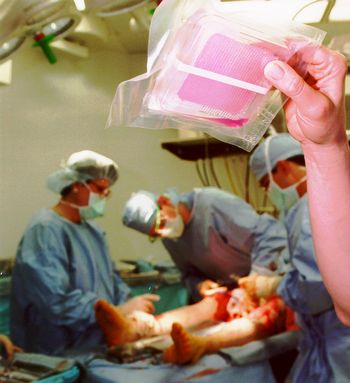Biological burn dressing may provide alternative to grafting

This biological burn dressing may replace painful skin grafting in some cases. (Photo by Donna Jones Bailey)
A new burn treatment that provides an alternative to skin grafting is being studied in the Burn Unit at Vanderbilt University Medical Center.
The treatment utilizes a special biological dressing called Composite Cultured Skin (CCS). It is designed to stimulate the body to rapidly regenerate its own skin, resulting in less scarring, less post-operative pain and wound contraction.
"This is a potential major step forward in treating burns," said Dr. R. Bruce Shack, chairman of the department of Plastic Surgery. "From our work already, it appears the CCS really does help burns to heal better and quicker. We are very pleased."
The experimental treatment can only be used on patients with second degree burns. These are burns that do not completely destroy the deeper layer of the skin, so that regeneration is still possible. However, if allowed to heal on their own, these burns take a prolonged time and can produce increased scarring.
The CCS biological dressing is made from skin that is usually discarded from circumcised newborns. These skin cells are then chemically divided into the upper-level cells (keratinocytes) and the deeper cells (fibroblasts). They are then cultured separately to enlarge the population of cells available from each foreskin and to reduce the cells' immunogenicity. These two cell lines are then impregnated into, and onto, a collagen sponge coated in a collagen gel.
"These natural cells produce growth factors that stimulated the patients' own skin to grow, gradually replacing the temporary cell population provided by the CCS burn dressing," Shack said.
The beauty of the treatment, Shack says, is that it may eliminate the need for skin grafting in some cases.
"We don't want to use autografts (skin grafting) all the time because you are taking the patient's good skin from another location and putting it onto the burned area. We want a replacement for this, a substitute for the traditional skin grafting and CCS is a promising substitute."
In preparation for the treatment, a patient's burned skin is removed the same as for a regular skin graft.
"The CCS is placed on the open wound, covering the area, just as a skin graft would. It covers the wound, reducing the risk of infection and allowing the burn to heal.
After CCS is applied, the area is wrapped with a standard burn pack for several days. Then the backing on the CCS patch is slowly peeled off, leaving the "new skin" in place.
Each CCS dressing is a two-inch-by-two-inch patch. Under the strict protocols of the study, up to four patches may be applied to each person's burns. The rest of the patient's burns are covered in skin grafts in standard fashion.
The study then compares the area treated with CCS to a comparable area treated with traditional autograft. Most of the patients have some good healing with CCS, Shack said, healing that is equivalent to that achieved with a skin graft.
Five patients have already been treated with the experimental CCS dressing. About 20 will be included in the total study at VUMC.
Ten other medical centers in the U.S. are participating in the clinical trial. VUMC has the largest number of patients.
After sufficient testing to prove safety and efficacy of CCS, FDA approval will be requested for the product. It could be on the market in three years.
Shack says the hope is that using CCS will help shorten hospital stays, will reduce the number of additional reconstructive surgical procedures a patient will need, will limit the need of physical and psychological rehabilitation and reduce overall treatment costs.
"I think the biggest hope is that CCS will replace the autograft in the treatment of patial-thickness burns. I particularly see this being important for infants who have such a small body surface area. We don't want to take their own skin to replace their burned skin. So if we can use something else, like CCS, that will be wonderful."
"The results are very preliminary," Shack says, "but very encouraging."













